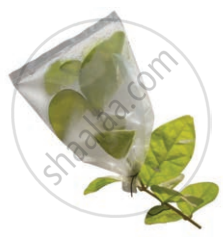Advertisements
Advertisements
Question
Observe the picture of an activity given as Figure carried out with leaves of plants and polythene bag.

Now answer the following.
- Which process is demonstrated in the activity?
- When will this activity show better results on a bright sunny day or a cloudy day?
- What will you observe in the polythene bag after a few hours of setting up the activity?
- Mention any one precaution you must.
Solution
- The process of transpiration is being demonstrate in the given activity. The loss of water in the vapour form from the exposed parts of a plant (mainly leaves) is called transpiration.
- The activity will show better results on a bright sunny day because the rate of transpiration increases in the presence of strong sunlight.
- After a few hours, small drops of water will be seen inside the polythene cover.
- (i) The set-up must be airtight.
(ii) Polythene bag must be dry.
(iii) The twig must be fresh with 10-12 leaves.
APPEARS IN
RELATED QUESTIONS
Differentiate between the following:
Parallel venation and reticulate venation
Tick the most appropriate answer
The flower is borne on a short stalk called
State if the following statement Is true or false. Correct the statement if it is false.
The transfer of the pollen grains from the anthers to the stigma of a flower is called fertilization.
State if the following statement Is true or false. Correct the statement if it is false.
Cluster of roots of about the same size is present in the fibrous root system.
Find the odd one out. Give reason.
We eat different parts of various plants. Write the part of the plant that we eat.
Lady's finger _________
Answer the following in short.
What are the prop roots?
Short Answer Type Question:
Why do we see dew drops on leaves in the early morning?
Long Answer Type Question:
What do you mean by leaf venation? Explain various types of leaf venation with example.
Arrange the following in the correct sequence.
Transpiration – Conduction - Absorption – Fixation
